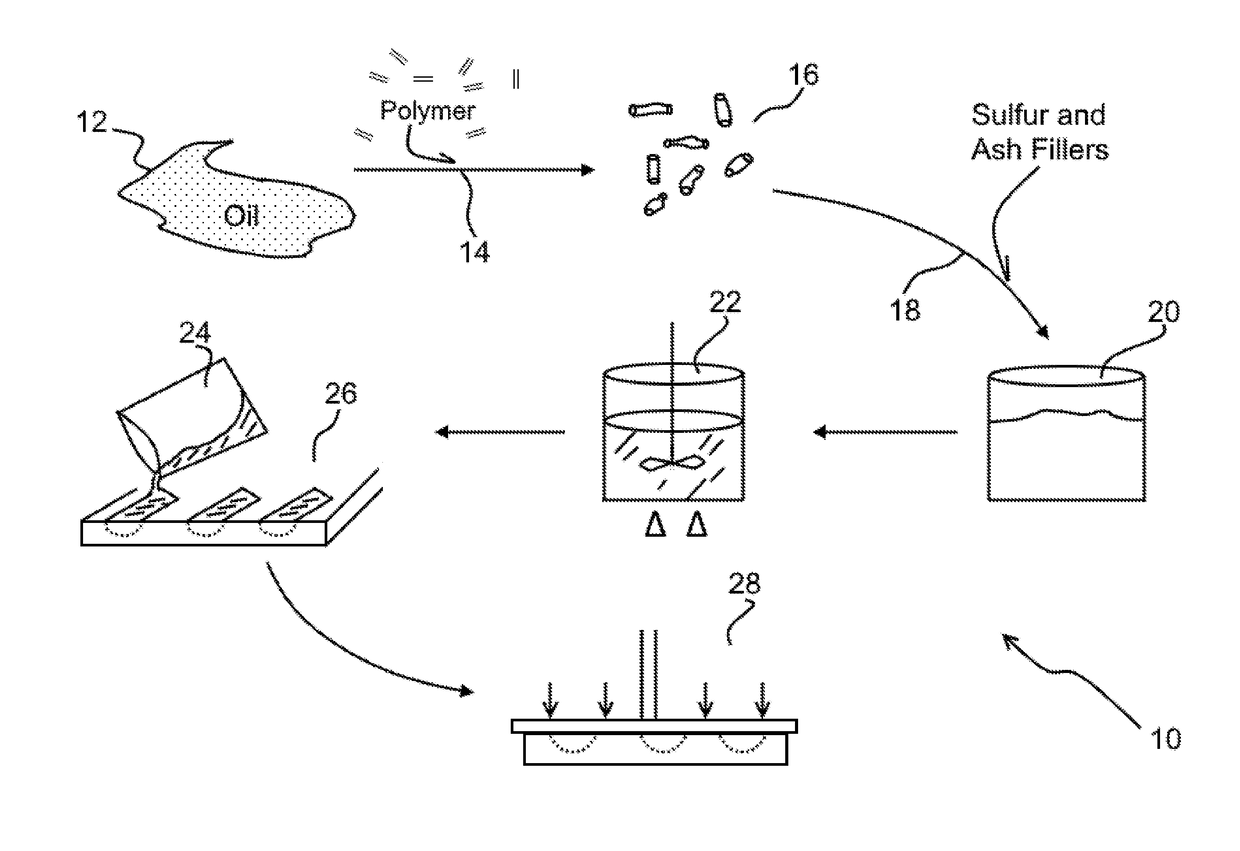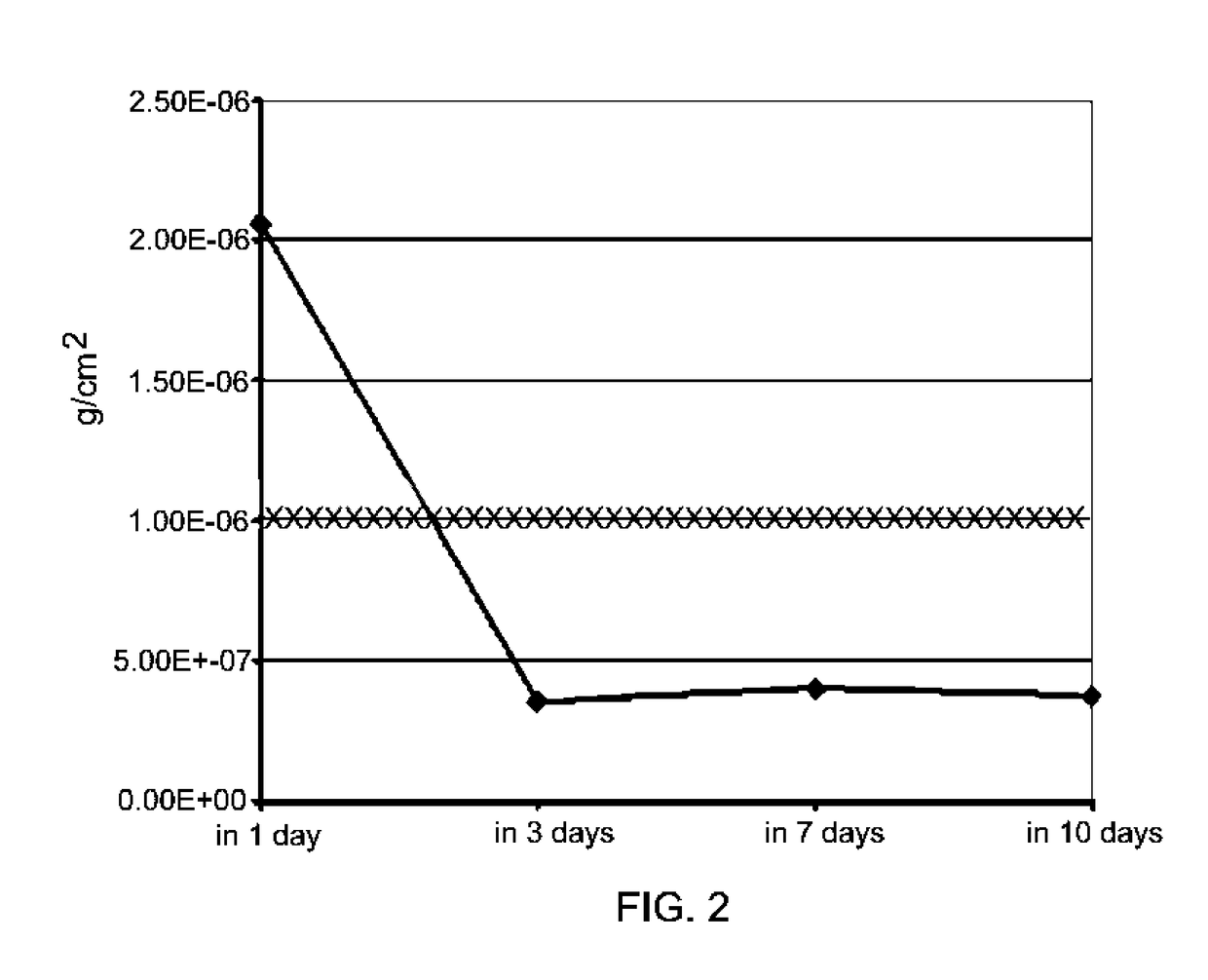Immobilization of organic radioactive and non-radioactive liquid waste in a composite matrix
a liquid waste and composite matrix technology, applied in the field of immobilizing radioactive waste, can solve the problems of contaminated oil needing to be disposed of safely, the construction is nothing more than a loose aggregate, and the requirements of the united states, so as to prevent water encroachment and low cost
- Summary
- Abstract
- Description
- Claims
- Application Information
AI Technical Summary
Benefits of technology
Problems solved by technology
Method used
Image
Examples
example 1
[0113]Experiments were performed on immobilization of styrene block co-polymer into sulfur composite saturated by a model solution of LRW (oil). A mixture was prepared and tested with the following composition: sulfur—40%, barite—20%, shale ash—40% with reinforcing chrysotile-asbestos additive, plasticizer and modifier. Different amounts of styrene block co-polymer saturated by model solution of LRW (oil) were introduced to this mixture.
[0114]The following composition was prepared: 30 ml of oil (with density of 0.88 g / cm3) were mixed with about 10 g of styrene block co-polymer and about 15 g of hardening mixture from elemental sulfur and ash in the ratio of about 1:2. Then, the oil-containing gelatinous mass and hardening mixture were mixed, and heated at a temperature of about 140° C. to form a homogeneous mixture, which was molded under pressure in the shape of cylindrical samples. The samples hardened after 3 minutes. Visually oil separation from the sample was not observed, the ...
example 2
[0115]Some variation was introduced in previous composition: 30 ml of oil (with density of 0.88 g / cm3) were mixed with about 10 g of styrene block co-polymer about 7-8 g of hardening mixture (elemental sulfur and ash in the ratio of about 1:2) and about 7-8 g of pure sulfur. Then, the mixture prepared was mixed with oil-containing gelatinous mass and hardening mixture, and heated at a temperature of about 140° C. to form a homogeneous mixture which was molded under pressure in the shape of cylindrical samples. The samples hardened after about 3 minutes. Visually, oil separation from the sample was not observed, and the obtained samples had the following characteristics: degree of oil inclusion in the composite—52 wt. % (65 vol. %), density—1.2 g / cm3, during compressive test the samples amortized without destruction, degree of leaching of radionuclides-2,4·10−7 g / (cm2·day).
[0116]The steps of preparation are as follows: The oil is added to polymer intermixed during several minutes. Th...
example 3
[0117]The mixture was prepared of the following composition: 10 g Nochar-910+80 ml oil. After intermixing the mixture obtained was placed into drying oven at 140° C. for 40 minutes. After heat treatment the mixture was placed into hot mold and compacted while cooling. The sample produced of a jelly like mass is presented in FIG. 32. The sample didn't show any release of oil during compacting and no change of weight being kept in water for one month period confirming the results obtained on leaching rate of Nochar-910 saturated with real LRW (oil) in 8.3.
[0118]Thus, the proposed method allows reliable localizing radioactive oil waste into the matrix, to provide a degree of incorporation of waste oil into the sulfur composite up to 78.5 vol %, extending the range of binders suitable for fixing waste oils in them, and improving the cost effectiveness of management of radioactive oil due to reduction of the volume of hardened waste, and using of sulfur as a hardening agent.
[0119]Polymer...
PUM
 Login to View More
Login to View More Abstract
Description
Claims
Application Information
 Login to View More
Login to View More - R&D
- Intellectual Property
- Life Sciences
- Materials
- Tech Scout
- Unparalleled Data Quality
- Higher Quality Content
- 60% Fewer Hallucinations
Browse by: Latest US Patents, China's latest patents, Technical Efficacy Thesaurus, Application Domain, Technology Topic, Popular Technical Reports.
© 2025 PatSnap. All rights reserved.Legal|Privacy policy|Modern Slavery Act Transparency Statement|Sitemap|About US| Contact US: help@patsnap.com



